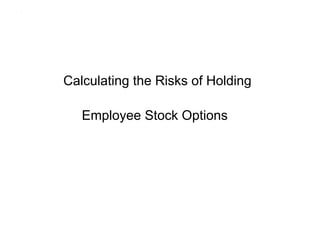
Risks Of Holding Es Os. (1)
- 1. . Calculating the Risks of Holding Employee Stock Options
- 2. . There are two substantial risks to holding employee stock options that this presentation will focus on. 1. The Delta Risk...the chance that the stock will go down thereby reducing the "fair value" of the options by a percentage of the drop of the stock within a short period of time. If an ESO has a .50 delta, the option is expected to drop 50 cents for a one dollar drop in the stock. 2. The Theta Risk... the chance that the "time value" will erode over time. These two risks will change as time passes and the stock has decreased or increased. For example the delta will increase from perhaps .55 to.65 if the stock goes from $100 to $110. On the other hand if the stock goes from $100 to $90, the delta may have dropped to .43. Time passing gives more delta to ESOs that are in-the-money and less delta to ESOs that are out-of-the-money ESOs.
- 3. . Let's assume that you were granted 1000 ESOs on a stock trading at $50. The delta at grant day may have been .62, with the "time value" equal to $22,000. Three years later when those options vest, the stock is trading at $75 and the delta (or equivalent stock position) is now .85. The "time value" may have dropped to $10,000, with $25,000 of "intrinsic value" for a total value of $35,000. If the stock remained near $75 at expiration day, the $10,000 'time value" is lost. If the stock was 20% lower from $75 (i.e. $60), the "time value is lost" and the" intrinsic value has dropped to $10,000. So the $35,000 of value decreased to $10,000 or down 70% from when the stock was $75.
- 4. . The position where the stock was $75 after vesting is highly risky and fiduciaries are required to try to reduce risk. Holders of ESOs are faced with this situation 3 times as often as they are faced with the situation of the stock trading at near $110. But no one seems to be interested in how to reduce risk when the stock is 50% above the strike after vesting. Why? The only method is to sell calls or buy puts in a way that efficiently reduces delta and erosion risks. There are some rare cases where that method is prohibited by the stock plans and sometimes the employee does not have the necessary funds to initiate the trades. But that strategy requires the wealth managers to perform way above their abilities. So they promote early exercise, sell and "diversify".